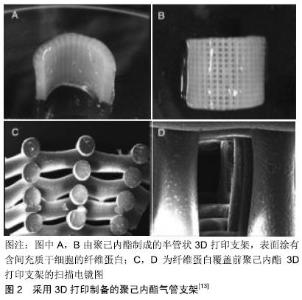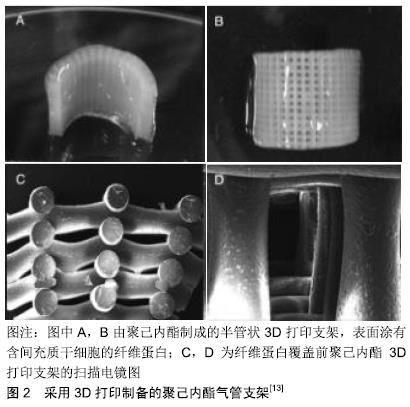Chinese Journal of Tissue Engineering Research ›› 2020, Vol. 24 ›› Issue (5): 780-786.doi: 10.3969/j.issn.2095-4344.2205
Previous Articles Next Articles
3D printing technology and tissue engineering technology in tracheal replacement: application and hotspot research
Liang Yanan1, Zhang Jianhua2
- 1Southern Medical University, Guangzhou 510220, Guangdong Province, China; 2Department of Thoracic Surgery, Shenzhen Hospital of Southern Medical University, Shenzhen 518000, Guangdong Province, China
-
Received:2019-05-21Revised:2019-06-11Accepted:2019-07-10Online:2020-02-18Published:2020-01-10 -
Contact:Zhang Jianhua, Chief physician, Department of Thoracic Surgery, Shenzhen Hospital of Southern Medical University, Shenzhen 518000, Guangdong Province, China -
About author:Liang Yanan, Master, Southern Medical University, Guangzhou 510220, Guangdong Province, China -
Supported by:Scientific Research Project of Baoan District Bureau of Health and Family Planning of Shenzhen City, No. 2017JD100
CLC Number:
Cite this article
Liang Yanan, Zhang Jianhua. 3D printing technology and tissue engineering technology in tracheal replacement: application and hotspot research[J]. Chinese Journal of Tissue Engineering Research, 2020, 24(5): 780-786.
share this article
Add to citation manager EndNote|Reference Manager|ProCite|BibTeX|RefWorks

2.1 气管替代物 气管有2个主要功能:①从喉部到支气管的机械稳定的密闭通道;②促进分泌物清除。第一个功能是通过管状结构完成的,管状结构由前软骨环和纵向肌肉支撑,它们共同提供了横向强度和纵向灵活性。第二种功能是通过具有同步纤毛的特殊上皮细胞来将分泌物沿黏膜向上排出[2]。气管置换面临的最大挑战是恢复血运及与外界的接触,气管依靠小血管的节段供血,这些小血管贯穿软骨环之间,为管腔黏膜内层供血。任何移植的气管、自体替代物或组织工程支架必须迅速建立自己的血液供应,以支持细胞代谢。另外,气管与外界的持续接触也是一个主要的障碍,因为外界环境往往是干燥的、充斥毒素和微生物的。与血管或髋关节等无菌环境不同,任何植入气道的异物最终都会暴露在病原体之下。当感染反复发生时,吻合口愈合会受到影响,如果不及时处理可能导致灾难性的裂开[3]。因此,气管的理想替代物应当具有横向硬度、纵向韧度,表面有纤毛的呼吸道上皮细胞,如果植入人造气管支架,这些外来材料应当具有生物相容性、无毒、非免疫原性和非致癌性,临床上应能抵抗脱位、侵蚀、狭窄、分泌物积聚和细菌定植[4]。 目前气管重建的方式主要有人工气管移植、同种异体移植、自体组织移植和组织工程气管移植,见表1。人工气管移植通常引起气管破裂、感染和狭窄,而导致移植失败的最严重问题是缺乏上皮[1];同种异体移植需要长期的免疫抑制治疗,移植后由于血管再生不足引起的坏死和感染往往导致死亡[5];自体组织复制气管结构和功能的能力有限,且存在手术创伤;而组织工程气管通过选择合适的支架材料,在支架中均匀地植入种子细胞,可以模拟与天然气管相似的生物结构和功能,似乎是气管替代物的理想选择[6]。此外,随着3D打印技术在医学方面的进步,可以设计出一种在管径大小和长度上适合患者的个体化气管支架,并提供合适的支撑力来维持组织工程气管的形状,为解决长段气管缺损问题提供了新思路。 "


2.2 组织工程及3D打印技术 自20世纪90年代Langer和Vacanti普及组织工程以来,组织工程为器官移植提供了潜在的无限的自体组织供应[7]。该方法利用生物工程技术促进组织再生,其主要思路是在生物降解支架上植入预先收集的宿主干细胞,在生物反应器中或植入人体后,宿主干细胞分化为成熟细胞,重新填充可降解支架,并最终通过沉积新的细胞外基质取代支架。另外在某些情况下,种子细胞可以通过释放各种细胞因子和化学物质来诱导宿主细胞,从而促进细胞在支架上的生长、增殖和分化[8]。3D打印技术诞生于20世纪90年代,最初应用于制造、航天模型设计等领域,现在它已迅速发展并被广泛应用于医学领域,其优点是:打印精度高;细胞及其支撑材料可同时打印;打印速度快,生产周期短;可根据个体定制,实现精准医疗等[9]。3D打印技术丰富了现有的组织工程技术,在一定程度上弥补了传统组织工程技术的许多不足和缺陷,这也是目前其受到广大组织工程研究人员青睐的原因[10]。3D打印机的头部不仅可以水平移动,而且可以垂直移动,实现了材料的逐层打印,从而形成了三维结构。因此,采用3D打印技术制备组织工程气管是可行的。 2.3 组织工程气管 目前,组织工程气管的研究热点主要包括3方面:支架材料、种子细胞及生物反应器。支架需要选择恰当的生物材料和制作方法,因为支架的生物相容性、生物活性(如细胞附着、增殖和分化)、机械性能、构架和三维环境(如有无孔隙、孔隙大小、孔隙相互连接性)极大地影响了组织的形成。干细胞具有增殖和自我更新的能力,是组织再生的关键组成部分。干细胞可以通过2种机制被趋聚到受损区域:在生物材料和/或可溶性因子(包括生长因子、趋化因子和细胞因子)的帮助下,与工程组织结合或依附到伤口部位。其中,间充质干细胞不仅具有较强的自我更新能力,且具有较长的存活能力,可分化为骨、软骨、脂肪、肌肉等不同细胞系,为组织工程气管再生提供了有效的细胞来源[11]。生物反应器可以为模拟体内条件的细胞提供机械刺激。这些机械信号在调节细胞功能和组织重塑进而产生与原生组织非常相似的工程化组织方面非常重要。此外,生物反应器有助于营养物质的灌注,这对于支持细胞在三维结构中的存活至关重要[12]。 2.3.1 支架材料 细胞-支架的相互作用对细胞行为有很大影响。一个好的支架应该具有支持细胞黏附、迁移、增殖和分化的特性,以及能够促进组织再生和重塑,而不会引起炎症或免疫原性反应,进而影响愈合。对于可生物降解支架,其主要作用是在支架上种植的软骨细胞或成软骨细胞构建细胞外基质形成软骨组织时,给予气道临时支撑,防止其塌陷。因此必须具有与软骨形成速率相匹配的降解速率,以保持结构的机械强度。快速降解的支架导致支架尺寸和孔隙度变小,难以将支架植入,阻碍细胞渗入支架;在体内,快速降解的支架在短时间内失去机械强度,导致移植物塌陷、气道堵塞。因此对于组织工程化气管,支架的机械强度十分重要,其在很大程度上取决于支架的材料和结构。许多材料已被测试用于制作组织工程气管支架,天然材料如明胶、纤维蛋白胶等具有良好的生物相容性和生物降解性,但其力学性能较差,不能满足组织工程的需要;合成材料如聚己内酯、聚乳酸-羟基乙酸共聚物、聚乙醇酸等,通常具有优异的机械强度,在组织工程气管中展现了其独特的优势。 其中,聚己内酯已经美国食品药品监督管理局(FDA)批准,被广泛用作3D打印的理想材料来源。聚己内酯分子链上的酯基具有生物相容性,其熔点较低(只有60 ℃),同时其热塑性好,易于加工成型。SCHANTZ等的研究发现,机械稳定的合成骨架(聚己内酯支架)和仿生水凝胶(纤维蛋白胶)的结合为骨组织工程应用提供了一个潜在的基质。CHANG等[13]以聚己内酯为材料结合3D打印技术制作了半管状支架,接种间充质干细胞后植入4只家兔10 mm×10 mm人为气管缺损处,术后4,8周对重建部分进行支气管镜、影像学、组织学和功能评估,结果未显示任何呼吸窘迫的迹象,见图2。PATRíCIO等[14]研究表明与熔融共混制备的聚己内酯/聚乳酸支架相比,溶剂浇铸制备的聚己内酯/聚乳酸支架具有更好的孔径缩小、力学性能和细胞黏附性。在最近的一项研究中,采用挤压成型法制备了具有完全连通孔隙的聚己内酯/羟基磷灰石复合支架[15]。LEE等[16]的研究表明移植了人鼻甲间充质干细胞的聚己内酯波纹管支架,能够成功地与邻近的天然气管组织结合,并且在管腔表面有邻近呼吸上皮的覆盖。有研究采用3D打印技术研究了聚己内酯多孔气管支架孔径和表面改性对其生物力学性能和生物相容性的影响[17]。适当的孔径和合理的纤维分布有利于细胞的增殖和分化,最终使组织再生。细胞黏附是细胞进一步生长的基础,是衡量材料生物相容性的必要指标。该研究表明,纳米二氧化硅改性多孔气管支架为细胞黏附和增殖提供了良好的界面,且孔径为200 μm多孔气管支架上的细胞活力最好[9]。同时也有研究表明,胶原或明胶的表面改性可以改善聚己内酯的亲水性,增强表面润湿性,促进较高的固定化,提高细胞的黏附和增殖[18-19]。WANG等[20]的研究结果表明,原始石墨烯的加入对细胞活力和增殖有积极影响,表面修饰可改善细胞的反应。由此可见,聚己内酯是制作组织工程气管的理想材料,值得进一步研究和探讨。 "


2.3.2 种子细胞 目前,临床前研究最广泛的3种气管种子细胞类型是间充质干细胞、软骨细胞和上皮细胞,它们反映了气管的组织组成。间充质干细胞由于能定向分化为骨、软骨、脂肪、肌肉等不同细胞系,而且能产生广泛的营养和免疫调节因子,易于分离,在体外可广泛扩增,此外还可以通过产生生长因子和细胞因子来保护现有细胞或抑制与器官损伤相关的炎症反应,促进宿主组织的存活和再生,被广泛应用于组织工程器官细胞再生中。骨髓间充质干细胞主要是从骨髓中分离出来的,但从脂肪、脐带和羊水等一系列其他组织中分离出来的间充质干细胞也已被证实。人类肺间充质干细胞与骨髓间充质干细胞具有一致的转录谱,提示骨髓间充质干细胞可能是组织工程应用的合适细胞来源[21]。 尽管是相对小规模的研究,越来越多的临床前证据支持骨髓间充质干细胞在组织工程气管中的益处。SUZUKI等[22]比较了同种异体大鼠脂肪来源间充质干细胞浸泡胶原海绵与单纯胶原在修复大鼠气管前壁缺损中的作用,发现间充质干细胞加入2周内加速了血管的形成和上皮的再生。HAN等[23]研究证明了骨髓间充质干细胞可以通过上调血管内皮生长因子的表达,增强低温保存的同种气管移植物的再血管化。BATIOGLU-KARAALTIN等[24]对比了兔模型中有无植入自体脂肪来源间充质干细胞脱细胞气管支架移植的效果,发现移植单纯的脱细胞气管支架更容易出现致命的移植早期分离、气道狭窄和感染,而植入间充质干细胞组在完整移植3个月后只有轻至中度水平的狭窄。CLARK等[25]还发现与无细胞对照移植物相比,植入了间充质干细胞的移植物具有更好的整合性。然而值得注意的是,尽管自体间充质干细胞可能有助于移植物的组织整合和再血管化,但它们并不能解决可能困扰原位气管置换移植物吻合口狭窄反复出现的问题[26]。 考虑到天然气管的复杂性,在最佳的生物工程气管移植中可能需要存在多种细胞类型。由于间充质干细胞有助于软骨细胞等其他细胞类型的适当增殖和分化,在体外也有助于内源性上皮细胞迁移以覆盖移植物,因此它们是联合播种的首选。HAYKAL等[27]报道的双重应用自体间充质干细胞和气管上皮细胞的异位猪模型,有助于保护脱细胞气管基质内的软骨,与单独的脱细胞支架相比,间充质干细胞诱发了免疫调节反应,并且增加了浸润调节性T细胞的数量。TSAO等[28]研究发现,共移植软骨细胞和间充质干细胞可生物降解人工气管支架上Ⅱ型胶原的表达量要高于接受单细胞或无细胞移植的支架。GO等[29]在另一项研究中也发现与接受裸支架或单细胞类型植入支架的动物相比,同时植入软骨细胞和上皮细胞的脱细胞支架术后狭窄和细菌污染程度较低,总体存活率也更高。这些临床前研究表明,在移植支架中同时植入多种细胞类型是有益的。 2.3.3 生物反应器 生物反应器在细胞与生物材料的相互作用中发挥着重要作用,是组织工程领域不可或缺的一个环节。生物反应器允许生产大而厚的组织工程结构,这是使用传统静置培养系统所不能实现的;还可以提供一个动态的培养环境,能够模拟体内条件的生理刺激和机械刺激,其操作条件(如pH值、温度、氧分压、营养供应)可以被控制。生物反应器可分为静态生物反应器和动态生物反应器,与静态生物反应器相比,动态培养系统具有更同质的细胞分布,允许液体流动以帮助营养供应和废物清除,并提供机械刺激(如水流剪切力、压缩、压力和拉伸)来指导适当的细胞分化、基质分泌和组织形成。机械稳定的软骨组织和管腔表面纤毛上皮细胞,对于保证正常的组织功能和减少并发症非常重要。这2种组织成分的存在可以显著降低由于黏液运输受损而引起的气道狭窄、气道阻塞和感染风险。 对于组织工程气管所使用的生物反应器应具有以下功能:①它应由2个部分组成,用于在支架的内外表面种植和培养分化不同类型的细胞;②它应该能够旋转使细胞均匀分布在基质中,以增强氧合、营养供应和废物清除;③它应提供一种水动力刺激,促进细胞的正常生长和分化[30]。如果生物反应器易于在无菌条件下操作、完全自动化且可以远程控制,就更理想了。TAN等[31]的研究表明,在灌注系统下进行细胞播种时软骨细胞分布更均匀,增殖更大。HAYKAL等[32]用生物反应器分别将上皮细胞和骨髓来源间充质干细胞植入脱细胞气管支架的管腔和外表面,发现与静置培养相比细胞附着程度更高、分布更均匀。 2.4 组织工程气管临床应用 目前,临床上已进行了十几例气管移植。2008年,MACCHIARINI等[33]报道了世界上首例30岁女性临床组织工程化气管移植。组织工程气管由脱细胞人气管制成,植入受者的气道上皮细胞和间充质干细胞来源软骨细胞在生物反应器中培养96 h,采用去污剂联合酶法对人气管进行脱细胞处理;在4个月的随访中受者没有出现排斥反应迹象,生活质量显著改善,不需要免疫抑制;随访5年观察移植物的长期稳定性,发现在靠近组织工程气管吻合的原生组织中出现了复发性瘢痕狭窄。然而,这并不影响患者的正常日常生活,功能检查提示患者肺功能、咳嗽敏感性及排痰能力均恢复正常[34]。这一研究结果提示,自体细胞联合脱细胞同种异体气管在未来可能为气管移植提供一种成功的功能性解决方案。然而该技术仍存在一些不足之处,如异体气管供应有限、脱细胞过程时间长等,需要解决这些问题才能转化为常规的临床应用。2011年JUNGEBLUTH等[35]报道了他们的经验:通过生物反应器在定制的人工生物纳米复合材料上种植骨髓单核细胞,为1例36岁男性患者行气管置换,该患者为原发性支气管癌复发,曾接受过切除手术及放射治疗,除了出现短暂的肺炎症状随后被成功治疗外,患者情况良好,术后1个月出院转中心医院;2个月后组织学证实上皮形成,血管新生且无感染。患者出院后恢复了正常的活动;5个月时患者无症状,气道几乎正常。该研究证明器官再生是可行的,不需要经过长时间的去细胞化过程,也不需要供体器官。2012年ELLIOT等[36]报道了1例10岁男孩接受组织工程气管移植后的2年随访,同样是对供体气管脱细胞后植入自体骨髓间充质干细胞,术后1周发现了血管形成的证据,分别在术后12,15,18个月出现再上皮化、纤毛上皮细胞形成和恢复机械强度,此后受体肺功能恢复正常,这是首例儿童组织工程气管移植。2014年BERG等[37]报道了1例76岁喉气管狭窄患者使用去污剂联合酶法制备人气管三维支架进行气管重建的结果,自体干细胞移植后出现真菌感染,治疗后好转,然而该患者在23 d后死于心脏骤停,解剖发现移植气管通畅稳定、吻合完整,组织病理学表现为鳞状上皮而非纤毛上皮及正常结缔组织,该研究作者认为还需要进一步的临床前研究。2015年STEINKE等[38]报道了1例26岁气管食管广泛缺损男性患者的2.5年随访结果,采用组织工程气管补片(来自猪空肠并保留其肠系膜)替换气管膜部,组织学分析显示气管完整,组织再生,气道表面覆盖着呼吸上皮,与天然上皮无明显区别。该研究作者认为,移植后的毛细血管网有助于组织向内生长愈合而没有瘢痕组织形成或塌陷。作者认为用于再生的支架在生物反应器中植入骨髓间充质干细胞、上皮细胞和软骨细胞,是目前为止描述的最可靠的再生方法。这种方法对于所使用的支架类型提供了灵活性,同种异体气管、主动脉或空肠移植物同样也值得应用来适应不同医疗机构的能力。合成支架由于省去了脱细胞时间,也许更适合临床应用,然而目前还没有比较使用不同支架临床效果的研究。 2.5 组织工程气管存在的问题 虽然组织工程气管具有巨大的潜力,但目前还存在许多障碍,影响了其在临床的广泛应用:①血管化的延迟:移植组织依靠血管提供营养和氧气,灌注不足难以满足细胞的需求。血管从上、下吻合处穿透气管移植物,这一过程需要数月才能完成,通常导致移植物中部坏死,组织坏死则导致炎症反应和狭窄。SAKAGUCHI等[39]的研究结果表明血管生成大约需要2个月的时间。目前,有以下几种方法可以加速新血管的形成:将内皮细胞植入气管移植物中,WALLES等[40]将自体内皮细胞植入脱细胞猪空肠血管网中生成血管化组织工程气管;提供血管生成因子,如重组人促红细胞生成素、血管内皮生长因子[36],此外,脱细胞支架中含有促进血管生成的碱性成纤维细胞生长因子[41];植入前预血管化,KIM等[42]将气管支架植入大网膜内预血管化1周;气管移植物包裹,即用宿主组织覆盖气管移植物,如大网膜或肌肉瓣[43],这些皮瓣能迅速使移植物恢复血管,使移植气管的缺血改变最小。②再上皮化:移植物的再上皮化被认为是对抗感染的一个关键因素[27]。在正常气管中管腔表面有一层假复层纤毛柱状上皮,在清除黏液和预防感染中起重要作用,缺乏纤毛柱状上皮可导致肉芽组织向内生长和痰液潴留、引起感染,甚至导致致命的气道阻塞。虽然可以通过临床干预加以纠正,但如果移植物移植前足够成熟,可以从一开始就避免这些并发症的发生。为了在移植前实现组织的体外成熟,使用生物反应器可能是目前最好的选择。PARK等[44]通过整体波纹管的三维打印研制出一种新颖的组织工程气管,将气管支架植入每只裸鼠的背部皮下。XU等[45]将脱细胞兔气管支架植入皮下来促进组织工程气管再生。此外,ZANI等[46]的研究发现呼吸道上皮细胞与血管内皮细胞间存在相互作用,共同调节气管的修复与重建。在这项研究中,作者发现上皮细胞和内皮细胞都能促进裸露的气管支架的上皮化,而当两种细胞同时存在时可以看到最佳的愈合。这些细胞采取不同的策略促进上皮化:上皮细胞似乎能够限制组织损伤和间充质增生,内皮细胞能够保护上皮细胞并维持血管化。由于上皮细胞和内皮细胞在气管上皮修复中都具有重要作用,因此在未来的组织工程气管中不仅要植入上皮细胞和软骨细胞,还要植入成纤维细胞和内皮细胞,以加速上皮的形成。③移植气管的生长(直径和长度):尤其对于儿童患者,移植气管的生长是至关重要的,因为儿童患者的身高会随着成长而增加。移植物不能生长可能会阻碍患者的成长,在最坏的情况下,由于不能满足成长中患者的需求,移植可能会失败。因此,需要进行详细深入的研究来确定移植气管的生长情况。HAMILTON等[47]的研究结果虽然显示移植气管两端的直径增加,但增加的原因可能是拉伸。此外,需要进一步解决的问题包括植入后功能气道的维护、移植气管的长期稳定性及与干细胞使用相关的理论致瘤风险等。 "

| [1] GRILLO HC.Tracheal replacement: a critical review.Ann Thorac Surg.2002;73(6):1995-2004. [2] UDELSMAN B, MATHISEN DJ, OTT HC. A reassessment of tracheal substitutes—a systematic review. Ann Cardiothorac Surg. 2018;7(2):175-182. [3] DELAERE P, VAN RAEMDONCK D.Tracheal replacement.J Thorac Dis2016;8(Suppl 2):S186-S196. [4] [ABOUARAB AA, ELSAYED HH, ELKHAYAT H, et al.Current Solutions for Long-Segment Tracheal Reconstruction.Ann Thorac Cardiovas.2017;23(2):66-75. [5] ELLIOTT MJ, HAW MP, JACOBS JP, et al. Tracheal reconstruction in children using cadaveric homograft trachea. Eur J Cardiothorac Surg.1996;10(9):707-712. [6] GAO M, ZHANG H, DONG W, et al. Tissue-engineered trachea from a 3D-printed scaffold enhances whole-segment tracheal repair.Sci Rep.2017;7(1):5246. [7] LANGER R, VACANTI JP. Tissue Engineering.Science. 1993; 260:920-926. [8] ROH J D, SAWH-MARTINEZ R, BRENNAN MP, et al. Tissue-engineered vascular grafts transform into mature blood vessels via an inflammation-mediated process of vascular remodeling.Proc Natl Acad Sci U S A. 2010;107(10): 4669-4674. [9] PAN S, ZHONG Y, SHAN Y, et al. Selection of the optimum 3D-printed pore and the surface modification techniques for tissue engineering tracheal scaffold in vivo reconstruction. J Biomed Mater Res A.2019;107(2):360-370. [10] HOLLISTER SJ, FLANAGAN CL, ZOPF DA, et al.Design Control for Clinical Translation of 3D Printed Modular Scaffolds. Ann Biomed Eng.2015;43(3):774-786. [11] 孙飞,史宏灿.组织工程气管替代治疗的临床转化研究进展[J].中华胸部外科电子杂志,2015,2(2):88-93. [12] LAW JX, LIAU LL, AMINUDDIN BS, et al. Tissue-engineered trachea: A review.Int J Pediatr Otorhinolaryngol. 2016;91: 55-63. [13] CHANG JW, PARK SA, PARK JK, et al.Tissue-engineered tracheal reconstruction using three-dimensionally printed artificial tracheal graft: preliminary report. Artif Organs. 2014; 38(6):E95-E105. [14] PATRÍCIO T, DOMINGOS M, GLORIA A, et al. Fabrication and characterisation of PCL and PCL/PLA scaffolds for tissue engineering.Rapid Prototyping J.2014;20(2):145-156. [15] DOMINGOS M, GLORIA A, COELHO J, et al. Three-dimensional printed bone scaffolds: The role of nano/micro-hydroxyapatite particles on the adhesion and differentiation of human mesenchymal stem cells.Proc Inst Mech Eng H. 2017;231(6):555-564. [16] LEE JY, PARK JH, CHO D. Comparison of tracheal reconstruction with allograft, fresh xenograft and artificial trachea scaffold in a rabbit model.J Artif Organs. 2018;21(3):325-331. [17] OBREGON F, VAQUETTE C, IVANOVSKI S, et al. Three-Dimensional Bioprinting for Regenerative Dentistry and Craniofacial Tissue Engineering.J Dent Res.2015;94(9_suppl): 143S-152S. [18] ZHANG F, QIAN Y, CHEN H, et al. The preosteoblast response of electrospinning PLGA/PCL nanofibers: effects of biomimetic architecture and collagen I.2016;11:4157-4171. [19] LI D, CHEN W, SUN B, et al.A comparison of nanoscale and multiscale PCL/gelatin scaffolds prepared by disc-electrospinning. Colloids Surf B Biointerfaces.2016;146: 632-641. [20] WANG W, CAETANO G, AMBLER W, et al. Enhancing the Hydrophilicity and Cell Attachment of 3D Printed PCL/Graphene Scaffolds for Bone Tissue Engineering. Materials.2016;9(12):992. [21] SINCLAIR KA, YERKOVICH ST, CHEN T, et al. Mesenchymal stromal cells are readily recoverable from lung tissue, but not the alveolar space, in healthy humans. Stem Cells. 2016;34(10):2548-2558. [22] SUZUKI T, KOBAYASHI K, TADA Y, et al. Regeneration of the trachea using a bioengineered scaffold with adipose-derived stem cells.Ann Otol Rhinol Laryngol.2008;117(6):453-463. [23] HAN Y, LAN N, PANG C, et al.Bone Marrow-Derived Mesenchymal Stem Cells Enhance Cryopreserved Trachea Allograft Epithelium Regeneration and Vascular Endothelial Growth Factor Expression. Transplantation. 2011;92(6): 620-626. [24] BATIOGLU-KARAALTIN A, KARAALTIN MV, OVALI E, et al. In Vivo Tissue-Engineered Allogenic Trachea Transplantation in Rabbits: A Preliminary Report.Stem Cell Rev Rep. 2015; 11(2):347-356. [25] CLARK ES, BEST C, ONWUKA E, et al.Effect of cell seeding on neotissue formation in a tissue engineered trachea.J Pediatr Surg.2016;51(1):49-55. [26] KANZAKI M, YAMATO M, HATAKEYAMA H, et al.Tissue engineered epithelial cell sheets for the creation of a bioartificial trachea.Tissue Eng.2006;12(5):1275-1283. [27] HAYKAL S, ZHOU Y, MARCUS P, et al.The effect of decellularization of tracheal allografts on leukocyte infiltration and of recellularization on regulatory T cell recruitment. Biomaterials.2013;34(23):5821-5832. [28] TSAO C, KO C, YANG S, et al. An ectopic approach for engineering a vascularized tracheal substitute. Biomaterials. 2014;35(4):1163-1175. [29] GO T, JUNGEBLUTH P, BAIGUERO S, et al. Both epithelial cells and mesenchymal stem cell–derived chondrocytes contribute to the survival of tissue-engineered airway transplants in pigs..J Thorac Cardiovasc Surg. 2010;139(2): 437-443. [30] BADER A, MACCHIARINI P. Moving towards in situ tracheal regeneration: the bionic tissue engineered transplantation approach.J Cell Mol Med.2010;14(7):1877-1889. [31] TAN Q, HILLINGER S, VAN BLITTERSWIJK CA, et al. Intra-scaffold continuous medium flow combines chondrocyte seeding and culture systems for tissue engineered trachea construction.Interact Cardiovasc Thorac Surg.2008;8(1):27-30. [32] HAYKAL S, SALNA M, ZHOU Y, et al. Double-chamber rotating bioreactor for dynamic perfusion cell seeding of large-segment tracheal allografts: comparison to conventional static methods. Tissue Eng Part C Methods. 2014;20(8):681-692. [33] MACCHIARINI P, JUNGEBLUTH P, GO T, et al. Clinical transplantation of a tissue-engineered airway.Lancet. 2008; 372(9655):2023-2030. [34] GONFIOTTI A, JAUS MO, BARALE D, et al. The first tissue-engineered airway transplantation: 5-year follow-up results.Lancet.2014;383(9913):238-244. [35] JUNGEBLUTH P, ALICI E, BAIGUERA S, et al. Tracheobronchial transplantation with a stem-cell-seeded bioartificial nanocomposite: a proof-of-concept study.Lancet. 2011;378(9808):1997-2004. [36] ELLIOTT MJ, DE COPPI P, SPEGGIORIN S, et al. Stem-cell-based, tissue engineered tracheal replacement in a child: a 2-year follow-up study.Lancet. 2012;380(9846): 994-1000. [37] BERG M, EJNELL H, KOVACS A, et al.Replacement of a tracheal stenosis with a tissue-engineered human trachea using autologous stem cells: a case report.Tissue Eng Part A. 2014;20(1-2):389-397. [38] STEINKE M, DALLY I, FRIEDEL G, et al. Host-integration of a tissue-engineered airway patch: two-year follow-up in a single patient.Tissue Eng Part A.2015;21(3-4):573-579. [39] SAKAGUCHI Y, SATO T, MURANISHI Y, et al. Development of a novel tissue-engineered nitinol frame artificial trachea with native-like physical characteristics.J Thorac Cardiovasc Surg. 2018; 156(3):1264-1272. [40] WALLES T, GIERE B, HOFMANN M, et al. Experimental generation of a tissue-engineered functional and vascularized trachea.J Thorac Cardiovasc Surg.2004;128(6):900-906. [41] BAIGUERA S, JUNGEBLUTH P, BURNS A, et al.Tissue engineered human tracheas for in vivo implantation. Biomaterials.2010;31(34):8931-8938. [42] KIM J, SUH SW, SHIN JY, et al.Replacement of a tracheal defect with a tissue-engineered prosthesis: early results from animal experiments.J Thorac Cardiovasc Surg.2004;128(1): 124-129. [43] WEIDENBECHER M, TUCKER HM, GILPIN DA, et al. Tissue-engineered trachea for airway reconstruction. Laryngoscope.2009;119(11):2118-2123. [44] PARK JH, HONG JM, JU YM, et al. A novel tissue-engineered trachea with a mechanical behavior similar to native trachea. Biomaterials.2015;62:106-115. [45] XU Y, LI D, YIN Z, et al.Tissue-engineered trachea regeneration using decellularized trachea matrix treated with laser micropore technique.Acta Biomater.2017;58:113-121. [46] ZANI BG, KOJIMA K, VACANTI CA, et al.Tissue-engineered endothelial and epithelial implants differentially and synergistically regulate airway repair.Proc Natl Acad Sci U S A. 2008;105(19): 7046-7051. [47] HAMILTON NJ, KANANI M, ROEBUCK DJ, et al. Tissue-Engineered Tracheal Replacement in a Child: A 4-Year Follow-Up Study.Am J Transplant. 2015;15(10): 2750-2757. |
| [1] | Lu Dezhi, Mei Zhao, Li Xianglei, Wang Caiping, Sun Xin, Wang Xiaowen, Wang Jinwu. Digital design and effect evaluation of three-dimensional printing scoliosis orthosis [J]. Chinese Journal of Tissue Engineering Research, 2021, 25(9): 1329-1334. |
| [2] | Zhang Tongtong, Wang Zhonghua, Wen Jie, Song Yuxin, Liu Lin. Application of three-dimensional printing model in surgical resection and reconstruction of cervical tumor [J]. Chinese Journal of Tissue Engineering Research, 2021, 25(9): 1335-1339. |
| [3] | Liu Zhengpeng, Wang Yahui, Zhang Yilong, Ming Ying, Sun Zhijie, Sun He. Application of 3D printed interbody fusion cage for cervical spondylosis of spinal cord type: half-year follow-up of recovery of cervical curvature and intervertebral height [J]. Chinese Journal of Tissue Engineering Research, 2021, 25(6): 849-853. |
| [4] | Xu Junma, Yu Yuechao, Liu Zhi, Liu Yu, Wang Feitong. Application of 3D-printed coplanar template combined with fixed needle technique in percutaneous accurate biopsy of small pulmonary nodules [J]. Chinese Journal of Tissue Engineering Research, 2021, 25(5): 761-764. |
| [5] | Wu Zijian, Hu Zhaoduan, Xie Youqiong, Wang Feng, Li Jia, Li Bocun, Cai Guowei, Peng Rui. Three-dimensional printing technology and bone tissue engineering research: literature metrology and visual analysis of research hotspots [J]. Chinese Journal of Tissue Engineering Research, 2021, 25(4): 564-569. |
| [6] | Huang Youyi, Yuan Wei. Application of 3D printing technology in fracture and deformity of foot and ankle [J]. Chinese Journal of Tissue Engineering Research, 2021, 25(3): 438-442. |
| [7] | Meng Lingjie, Qian Hui, Sheng Xiaolei, Lu Jianfeng, Huang Jianping, Qi Liangang, Liu Zongbao. Application of three-dimensional printing technology combined with bone cement in minimally invasive treatment of the collapsed Sanders III type of calcaneal fractures [J]. Chinese Journal of Tissue Engineering Research, 2021, 25(24): 3784-3789. |
| [8] | Hu Jing, Xiang Yang, Ye Chuan, Han Ziji. Three-dimensional printing assisted screw placement and freehand pedicle screw fixation in the treatment of thoracolumbar fractures: 1-year follow-up [J]. Chinese Journal of Tissue Engineering Research, 2021, 25(24): 3804-3809. |
| [9] | Shu Qihang, Liao Yijia, Xue Jingbo, Yan Yiguo, Wang Cheng. Three-dimensional finite element analysis of a new three-dimensional printed porous fusion cage for cervical vertebra [J]. Chinese Journal of Tissue Engineering Research, 2021, 25(24): 3810-3815. |
| [10] | Liu Keke, Duan Xin, Ma Xiangrui, Zhang Yuntao. Effect of cinnamaldehyde on osteoblasts in high glucose environment with the electrospinning membrane as a carrier [J]. Chinese Journal of Tissue Engineering Research, 2021, 25(22): 3500-3504. |
| [11] | Zhang Zhenhua, Liu Zichen, Yu Baoqing. Status and problems of polycaprolactone and its composite materials in bone tissue engineering [J]. Chinese Journal of Tissue Engineering Research, 2021, 25(22): 3571-3577. |
| [12] | Chen Jie, Liao Chengcheng, Zhao Hongbo, Zhao Wei, Chen Zhiwei, Wang Yan. Application of tissue engineering urethral stent and its preparation technology in urethral reconstruction [J]. Chinese Journal of Tissue Engineering Research, 2021, 25(22): 3591-3596. |
| [13] | Pan Xuan, Zhao Meng, Zhang Xiumei, Zhao Jie, Zhai Yunkai. Research and application of biological three-dimensional printing technology in the field of precision medicine: analysis of Chinese and English literature [J]. Chinese Journal of Tissue Engineering Research, 2021, 25(21): 3382-3389. |
| [14] | Li Congcong, Yao Nan, Huang Dane, Song Min, Peng Sha, Li Anan, Lu Chao, Liu Wengang. Identification and chondrogenic differentiation of human infrapatellar fat pad derived stem cells [J]. Chinese Journal of Tissue Engineering Research, 2021, 25(19): 2976-2981. |
| [15] | Du Xueting, Yang Yang, Huang Wenhua, Chen Wubiao. Clinical application and breakthrough of three-dimensional printing based on medical imaging technology [J]. Chinese Journal of Tissue Engineering Research, 2021, 25(18): 2887-2894. |
| Viewed | ||||||
|
Full text |
|
|||||
|
Abstract |
|
|||||